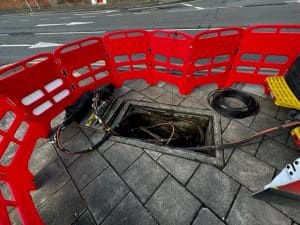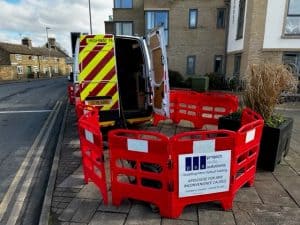This fibre optic cabling contract requires our engineers to travel all over the UK. What’s more, this client is one of the largest UK fibre broadband network providers. Our task on the contract is to identify dark fibre and bring them into service. Equally important is that in doing so we do not disconnect active fibres or cause network faults. This is how we achieve the contract requirements.
Fiber optic checker
Firstly, the task of locating the correct chamber where the required fibre cable has been identified is to be housed. Secondly, we have to set up a safe working site with the required sign lighting and guarding. This then allows us to pull out the fibre joint for inspection. The location of the fibre cable pit varies, and so does the condition of the fibre joint to be worked on. Our vehicles are equipped with all the Signing & guarding required, and our engineers are NRSWA qualified to set up a safe working site. Finally, when traffic management is required, specialist contractors provide the necessary services.
The fibre optic joint generally has a sufficient service loop to allow the joint to be pulled into the van for the work to be carried out. The first step in the fibre optic testing is to identify the fibre cores placed on the work pack as spare. This information being legacy cannot be taken for granted, so the fibre engineers use an optical fiber checker to see if the fibre cores carry light signals. These Fujikura FID-30R fibre checkers only require the fibre to be placed in the head so do not stop the data transmission.




Fibre Optic test
Once we have proved that the fibre cores are spare, the next stage of fibre optic testing can take place. Firstly, a two-person team uses a Light source and power meter to light up the fibre to prove the cores. The next stage requires an OTDR to test and check whether the fibre cores provide the required route length. To commission the entire route, the process often requires repeating to identify many fibre cores through fibre optic chambers. This will require the fibre splicing of cores in various cables to provide the route.
Once the entire route is fibre-spliced then the final fibre-optic testing using OTDR and CD/PMD testers is carried out. This is to ensure the fibre cable route is in compliance with the network specification.
Optical Fibre Splicing
Once the spare cores in the fibre cables have been identified, they require joining to provide the communication path. This is achieved using a fusion splicer; we use Fujikura 70 & 90s splicers, a leading manufacturer of splice machines. Our experienced fibre engineers then prepare the fibre cable for fusion splicing and dressing back into the termination. Finally, this requires the preparation of the fibre cores, which need to be cleaved to ensure a clean and smooth surface. So, that can be fusion sliced without causing reflection or dispersion of the light signal. The engineers use a fibre scope to look at the core end and fibre connectors to ensure they are clean. If they are not clean, it will cause the fibre optic testing to fail and require resplicing. The images below display what the scope shows that the naked eye cannot see.




Fibre Optic Testing Services
Testing fibre optic cabling requires a considerable amount of knowledge and equipment. So if you have a fibre testing requirement talk to us for the very best solutions and advice. You can call on 0800 0213 264 or contact us via our “Request a Quote or Survey” form.
You can pop back to our Fibre Optic Testing services page for more information or give us a call we are happy to discuss how we can be of service.